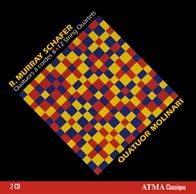The world loves grand gestures — big opera, loud rock concerts, tall-and-taller buildings. But those who meditate on happiness inevitably turn to the small, everyday gesture for sustenance — a smile, a pathside wildflower, a gentle nose-prod from the family dog. I want to add the string quartet to the latter list.
- Classical Music 101: What Does A Conductor Do? - June 17, 2019
- Classical Music 101 | What Does Period Instrument Mean? - May 6, 2019
- CLASSICAL MUSIC 101 | What Does It Mean To Be In Tune? - April 23, 2019
And I also want to suggest that there may be nothing finer in Canadian composer R. Murray Schafer’s output than his string quartets. In writing for two violins, a viola and a cello, he turns his back on the grand gestures of his symphonic and quasi-operatic work, focusing on telling stories in music using the most economical means possible.
These are stories and depictions, in a very old-fashioned sense. But fashioned in Schafer’s own language, which isn’t ideologically tonal or atonal. It, like Being, Is.
 An excellent new ATMA-released 2-CD recording of Schafer’s five most recent string quartets — Nos. 8 through 12 — by Montreal’s Molinari Quartet is so well done that it encourages the listener to play each piece over and over again to savour the composer’s craft and the musicians’ skill in rendering it as fine music.
An excellent new ATMA-released 2-CD recording of Schafer’s five most recent string quartets — Nos. 8 through 12 — by Montreal’s Molinari Quartet is so well done that it encourages the listener to play each piece over and over again to savour the composer’s craft and the musicians’ skill in rendering it as fine music.
(Note that the recording of String Quartet No. 8 is from 2002; the others are new.)
Schafer tends to request traditional bowing and plucking, with the occasional tap of the strings from the wooden side of the bow, or a rap of knuckles on an instrument’s body.
Quartet No. 9 — my favourite — includes a recorded treble voice singing a five-note theme born in Quartet No. 8. It also includes the sounds of children laughing and playing, as if from a schoolyard at recess.
This brings up one more thing that makes this music interesting — compelling, even: the coexistence of light and dark.
If you’ve never done this before, on your next walk through a pre-Modern gallery at the AGO look at the landscapes and still lifes and portraits and note how some painters build their work on light. Others rely on shadow.
The great composers do the same.
Is Schafer about light or is he about the darker recesses of existence? The answer is most ambiguous in Quartet No. 9, but that ambiguity (or duality) informs all of the music on the disc, and the Molinaris navigate it with such elegance.
Here is the composer himself reading the text that goes along with String Quartet No. 10 in the promotional video made during the recording session in Mirabel, Qué.:
For more information on the album, click here.
John Terauds
- Classical Music 101: What Does A Conductor Do? - June 17, 2019
- Classical Music 101 | What Does Period Instrument Mean? - May 6, 2019
- CLASSICAL MUSIC 101 | What Does It Mean To Be In Tune? - April 23, 2019




